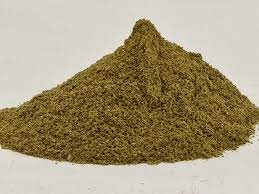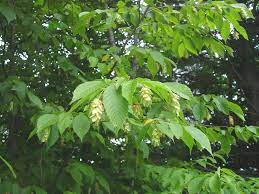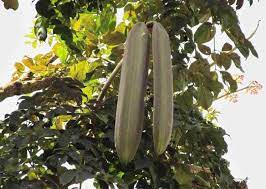Oroxylum indicum, commonly known as Shyonaka, is a deciduous tree native to the Indian subcontinent and Southeast Asia. Belonging to the Bignoniaceae family, it is valued for its medicinal properties and various uses in traditional medicine systems.
Shyonaka typically grows to a height of 10 to 15 meters, with a spreading canopy of large, compound leaves that are reminiscent of those of the neem tree. The tree produces clusters of pale pink to lavender flowers with distinctive long, protruding stamens, which bloom during the spring season.
One of the most notable features of Oroxylum indicum is its large, flat seed pods, which can reach lengths of up to one meter. These pods contain numerous seeds and are often used in traditional medicine preparations.
In Ayurveda, the traditional medicine system of India, various parts of the Shyonaka tree are utilized for their medicinal properties. The bark, leaves, flowers, and seeds are believed to have therapeutic effects and are used to treat a range of health conditions, including respiratory ailments, digestive disorders, and skin problems.
In addition to its medicinal uses, Shyonaka has cultural significance in the regions where it grows. It is often revered for its symbolism and spiritual associations, featuring in religious rituals and ceremonies.
Cultivation of Oroxylum indicum is relatively straightforward, as it thrives in tropical and subtropical climates with well-drained soil and ample sunlight. The tree is often grown for its medicinal value in home gardens and herbal plantations.
Overall, Shyonaka, or Oroxylum indicum, is a valuable tree species with both medicinal and cultural importance. Its distinctive appearance, along with its potential health benefits, makes it a cherished component of traditional medicine systems and natural landscapes in the regions it inhabits.
The Botanical Description of Oroxylum indicum
1. Leaf Structure: Oroxylum indicum, commonly known as Indian trumpet flower or Shyonaka, features pinnate leaves with serrated edges. The leaves are arranged alternately along the stem.
2. Flower Characteristics: The distinctive trumpet-shaped flowers of Oroxylum indicum are marked by a pale pink to lavender hue. These flowers form clusters at the end of branches.
3. Fruit Formation: The fruit of Oroxylum indicum is a pod, elongated and woody, containing numerous seeds. The pods develop after the flowering season.
4. Bark Texture: The bark of this tree is rough and furrowed, providing protection to the inner layers. It exhibits a grayish-brown coloration.
5. Tree Height: Oroxylum indicum is a deciduous tree that can reach impressive heights, often growing up to 25 meters tall.
6. Root System: The root system is robust, anchoring the tree securely into the soil. It plays a crucial role in nutrient absorption.
7. Seasonal Changes: Oroxylum indicum undergoes seasonal changes, shedding its leaves during the dry season and regenerating them with the arrival of the rainy season.
8. Trunk Diameter: The trunk of Oroxylum indicum is sturdy and can have a considerable diameter, providing structural support to the entire tree.
9. Sunlight Requirements: This tree thrives in full sunlight, preferring well-lit environments for optimal growth and development.
10. Distinctive Features: Notable features include the compound leaves, large flowers, and the unique pod-like fruits that set Oroxylum indicum apart.
The Geographic Distribution of Oroxylum indicum

1. Indian Subcontinent: Oroxylum indicum is native to the Indian subcontinent, thriving in countries such as India, Nepal, Sri Lanka, and Bangladesh.
2. Southeast Asia: Beyond the Indian subcontinent, this tree is also found in parts of Southeast Asia, including Thailand, Myanmar, and Malaysia.
3. China: Oroxylum indicum extends its geographical reach into southern China, where it can be found in specific regions.
4. Tropical Regions: This species favors tropical climates, being well-distributed in areas characterized by warm temperatures and high humidity.
5. Altitude Range: While Oroxylum indicum is typically found at lower altitudes, it can adapt to a range of elevations, from plains to foothills.
6. Forested Areas: The tree prefers habitats with well-defined wet and dry seasons, often thriving in forested areas with diverse flora.
7. Riparian Zones: Oroxylum indicum shows a propensity for riparian zones, where its roots benefit from proximity to water sources like rivers and streams.
8. Human Cultivation: In some regions, Oroxylum indicum is cultivated for its medicinal properties and as an ornamental tree.
9. Biotic Associations: The tree interacts with various organisms, contributing to the biodiversity of the ecosystems it inhabits.
10. Global Presence: Oroxylum indicum’s presence has expanded beyond its native regions, with efforts made to introduce and cultivate it in other parts of the world.
11. Unique Habitats: It can adapt to different soil types and ecological niches, showcasing its resilience and ability to thrive in diverse habitats.
12. Conservation Status: While not currently listed as endangered, ongoing monitoring of its populations is essential due to habitat changes and potential threats.
The Chemical Composition of Oroxylum indicum
1. Alkaloids: Oroxylum indicum contains alkaloids, bioactive compounds that contribute to its medicinal properties.
2. Flavonoids: The presence of flavonoids adds antioxidant properties to Oroxylum indicum, aiding in the neutralization of free radicals.
3. Tannins: Tannins are found in the bark and leaves, contributing to the astringent qualities of the plant.
4. Sterols: Oroxylum indicum contains sterols, which play a role in various physiological processes and may contribute to its medicinal effects.
5. Phenolic Compounds: Phenolic compounds in the plant contribute to its anti-inflammatory and antimicrobial properties.
6. Terpenoids: Terpenoids are part of Oroxylum indicum’s chemical makeup, showcasing its potential in traditional medicine.
7. Essential Oils: Certain parts of the plant may contain essential oils, which can have aromatic and therapeutic qualities.
8. Saponins: The presence of saponins contributes to the plant’s foaming properties and may have potential health benefits.
9. Minerals: Oroxylum indicum accumulates essential minerals from the soil, adding to its nutritional value.
10. Vitamins: The plant may contain vitamins, enhancing its overall nutritional profile and potential health benefits.
11. Organic Acids: Some organic acids contribute to the plant’s taste profile and may have physiological effects.
12. Lignans: Lignans are present in Oroxylum indicum, and research suggests potential health-promoting properties associated with these compounds.
13. Polysaccharides: Certain polysaccharides contribute to the plant’s structural components and may have immunomodulatory effects.
Read Also: Why Eggs Are Good For You – The Exceptional Super Food for Your Health
The Medicinal Health Benefits Of Oroxylum indicum (Shyonaka)

1. Respiratory Health: Oroxylum indicum is known for its beneficial effects on respiratory health. It can help alleviate symptoms of cough, cold, and bronchitis.
2. Digestive Disorders: The plant possesses digestive properties, aiding in the treatment of various digestive disorders such as indigestion, gastritis, and diarrhea.
3. Anti-inflammatory Effects: Oroxylum indicum exhibits anti-inflammatory properties, which can help reduce inflammation associated with conditions like arthritis and inflammatory bowel disease.
4. Antioxidant Activity: The presence of antioxidants in Oroxylum indicum helps combat oxidative stress and may lower the risk of chronic diseases such as cancer and cardiovascular disorders.
5. Immunomodulatory Effects: It has been found to modulate the immune system, enhancing the body’s natural defense mechanisms against infections and diseases.
6. Antimicrobial Properties: Oroxylum indicum demonstrates antimicrobial activity against various pathogens, including bacteria, viruses, and fungi, making it valuable in fighting infections.
7. Hepatoprotective Benefits: The plant has hepatoprotective properties, supporting liver health and protecting against liver damage caused by toxins and oxidative stress.
8. Antidiabetic Potential: Studies suggest that Oroxylum indicum may help regulate blood sugar levels and improve insulin sensitivity, offering potential benefits for individuals with diabetes.
9. Wound Healing: Oroxylum indicum promotes wound healing due to its antimicrobial and anti-inflammatory properties, accelerating the recovery process.
10. Anticancer Activity: Research indicates that Oroxylum indicum exhibits anticancer effects by inhibiting the growth of cancer cells and inducing apoptosis, potentially contributing to cancer prevention and treatment.
11. Antipyretic Effects: It has been traditionally used to reduce fever and alleviate associated symptoms, providing relief during times of illness.
12. Analgesic Properties: Oroxylum indicum may have analgesic effects, helping to alleviate pain associated with various conditions such as headaches, muscle aches, and joint pain.
13. Antispasmodic Effects: The plant can help relieve muscle spasms and cramps, promoting relaxation and comfort.
14. Antiulcer Activity: Oroxylum indicum may protect against gastric ulcers by reducing gastric acid secretion and enhancing mucosal defense mechanisms.
15. Neuroprotective Effects: Preliminary studies suggest that Oroxylum indicum may have neuroprotective properties, potentially benefiting cognitive function and neurological health.
16. Cardiovascular Health: It may contribute to cardiovascular health by lowering cholesterol levels, improving blood circulation, and reducing the risk of heart disease.
17. Menstrual Disorders: Oroxylum indicum has been used in traditional medicine to alleviate symptoms of menstrual disorders such as irregular periods and menstrual cramps.
The Methods of Usage to Achieve the Provided Health Benefits Of Oroxylum indicum (Shyonaka)
1. Decoction: Prepare a decoction by boiling Oroxylum indicum bark or leaves in water. This can be consumed as a tea or tonic to obtain its medicinal benefits.
2. Powdered Form: The dried parts of Oroxylum indicum can be ground into a fine powder and consumed directly or added to food or beverages for easy ingestion.
3. Herbal Infusion: Steep Oroxylum indicum leaves or flowers in hot water to make an herbal infusion. This can be consumed as a tea for its therapeutic effects.
4. Extracts and Tinctures: Commercially available extracts and tinctures of Oroxylum indicum are convenient forms of consumption, providing concentrated doses of its active constituents.
5. Capsules and Tablets: Oroxylum indicum supplements are available in capsule or tablet form, allowing for precise dosing and convenient consumption.
6. External Applications: Oroxylum indicum extracts or poultices can be applied topically to the skin to promote wound healing, reduce inflammation, or alleviate skin conditions.
7. Culinary Use: Incorporate Oroxylum indicum leaves, flowers, or fruits into culinary preparations such as soups, stews, or salads to enjoy their nutritional and medicinal benefits.
8. Traditional Formulations: Many traditional medicine systems utilize Oroxylum indicum in various formulations, including Ayurvedic, traditional Chinese medicine, and folk remedies.
9. Complementary Therapy: Oroxylum indicum can be used alongside conventional medical treatments as a complementary therapy to enhance overall health and well-being.
10. Herbal Baths: Adding Oroxylum indicum extracts or infusions to bathwater can provide relaxation and promote skin health through absorption.
11. Inhalation: Inhaling the steam from Oroxylum indicum preparations can help alleviate respiratory symptoms such as congestion and cough.
12. Herbal Syrups: Prepare herbal syrups by combining Oroxylum indicum extracts with sweetening agents. These syrups are easy to consume and can be used to soothe throat irritation or cough.
13. Mouthwash: Infuse Oroxylum indicum extracts into a mouthwash solution to promote oral health and freshen breath.
The Side Effects Of Using Oroxylum indicum Medicinal Plant
1. Gastrointestinal Upset: In some individuals, consumption of Oroxylum indicum may cause gastrointestinal discomfort such as nausea, vomiting, or diarrhea.
2. Allergic Reactions: Individuals with allergies to plants in the same family as Oroxylum indicum may experience allergic reactions upon exposure.
3. Drug Interactions: Oroxylum indicum may interact with certain medications, particularly those metabolized by the liver or with blood-thinning properties. Consultation with a healthcare professional is advised.
4. Pregnancy and Lactation: Pregnant and breastfeeding women should exercise caution when using Oroxylum indicum, as its safety during these periods has not been well studied.
5. Photosensitivity: Some individuals may experience increased sensitivity to sunlight or UV radiation after consuming or applying Oroxylum indicum preparations topically.
6. Liver Toxicity: High doses of Oroxylum indicum may potentially cause liver toxicity, particularly in susceptible individuals or with prolonged use.
7. Central Nervous System Effects: Excessive consumption of Oroxylum indicum may lead to central nervous system effects such as dizziness, sedation, or confusion.
8. Skin Irritation: Topical application of Oroxylum indicum extracts may cause skin irritation or allergic reactions in sensitive individuals.
9. Renal Effects: Individuals with kidney disorders should use Oroxylum indicum with caution, as excessive consumption may affect renal function.
10. Respiratory Effects: Inhalation of Oroxylum indicum preparations may trigger respiratory irritation or exacerbate existing respiratory conditions in susceptible individuals.
11. Hormonal Effects: Oroxylum indicum may have hormonal effects in the body, potentially affecting hormone-sensitive conditions or medications.
12. Long-Term Effects: The long-term effects of prolonged or excessive use of Oroxylum indicum are not well understood and warrant further research.
Read Also: Hookworms: Description, Damages Caused, Control and Preventive Measures
The Scientific Research and Studies of Oroxylum indicum

1. Anti-inflammatory Activity: Research has shown that extracts of Oroxylum indicum possess significant anti-inflammatory properties, inhibiting inflammatory mediators and pathways in vitro and in animal studies.
2. Antioxidant Effects: Studies have demonstrated the antioxidant activity of Oroxylum indicum, which may help protect against oxidative stress-related diseases such as cancer, cardiovascular disorders, and neurodegenerative conditions.
3. Antimicrobial Potential: Oroxylum indicum extracts exhibit broad-spectrum antimicrobial activity against various bacteria, viruses, and fungi, suggesting potential applications in infectious disease management.
4. Hepatoprotective Properties: Experimental studies have indicated that Oroxylum indicum has hepatoprotective effects, protecting the liver from damage induced by toxins, drugs, or pathological conditions.
5. Anticancer Properties: Preclinical studies have shown promising anticancer effects of Oroxylum indicum extracts against various cancer cell lines, including breast, lung, colon, and prostate cancers, highlighting its potential as a natural anticancer agent.
6. Immunomodulatory Effects: Research suggests that Oroxylum indicum can modulate the immune system, enhancing immune responses against infections and diseases while regulating immune-mediated inflammatory processes.
The Safety Precautions and Recommendations In Using Oroxylum indicum Medicinal Plant
1. Dosage Considerations: It is essential to follow recommended dosage guidelines when using Oroxylum indicum to minimize the risk of adverse effects and toxicity.
2. Consultation with Healthcare Provider: Individuals with preexisting medical conditions, pregnant or breastfeeding women, and those taking medications should consult with a healthcare professional before using Oroxylum indicum.
3. Quality and Purity: Ensure that Oroxylum indicum products are obtained from reputable sources and undergo quality testing to guarantee purity and safety.
4. Allergy Testing: Conduct a patch test or allergy test before using Oroxylum indicum topically or internally, especially for individuals with known allergies to plants in the same family.
5. Monitoring for Side Effects: Monitor for any adverse reactions or side effects when using Oroxylum indicum, and discontinue use if any symptoms occur.
6. Avoiding Excessive Use: Use Oroxylum indicum in moderation and avoid excessive consumption or prolonged use to prevent potential toxicity or adverse effects.
7. Interactions with Medications: Be aware of potential interactions between Oroxylum indicum and medications, particularly those with known interactions with herbs or supplements.
8. Storage and Handling: Store Oroxylum indicum products properly in a cool, dry place away from direct sunlight and moisture to maintain their efficacy and safety.
9. Pregnancy and Lactation: Pregnant or breastfeeding women should use Oroxylum indicum with caution and under the guidance of a healthcare provider due to limited safety data.
10. Adverse Reactions Reporting: Report any adverse reactions or side effects associated with Oroxylum indicum use to healthcare professionals or regulatory authorities for proper evaluation and management.
11. Age Considerations: Use caution when administering Oroxylum indicum to children or elderly individuals, as their tolerance and response to herbal remedies may differ from adults.
12. Continuous Evaluation: Continuously evaluate the safety and efficacy of Oroxylum indicum products through clinical studies and pharmacovigilance efforts to ensure optimal patient outcomes and public health.
FAQs About Oroxylum indicum Medicinal Plant
1. Is Oroxylum indicum safe for long-term use?
Yes, Oroxylum indicum can be used safely for long-term purposes when consumed in moderation and under the guidance of a healthcare professional.
2. Can Oroxylum indicum be used during pregnancy?
Pregnant women should use Oroxylum indicum with caution and consult with a healthcare provider before use due to limited safety data during pregnancy.
3. Are there any known drug interactions with Oroxylum indicum?
Oroxylum indicum may interact with certain medications, particularly those metabolized by the liver or with blood-thinning properties. Consultation with a healthcare provider is advised.
4. How should Oroxylum indicum be stored?
Oroxylum indicum products should be stored in a cool, dry place away from direct sunlight and moisture to maintain their potency and efficacy.
5. Can Oroxylum indicum be used topically?
Yes, Oroxylum indicum extracts or preparations can be applied topically to the skin for various purposes, including wound healing, inflammation reduction, and skin health promotion.
6. Is there any age restriction for using Oroxylum indicum?
While Oroxylum indicum is generally safe for use in adults, caution should be exercised when administering it to children or elderly individuals, and dosage adjustments may be necessary.
7. How quickly can I expect to see results from using Oroxylum indicum?
The onset of therapeutic effects may vary depending on the individual, the condition being treated, and the dosage form and regimen used. Consult with a healthcare provider for personalized guidance.
8. Are there any contraindications for using Oroxylum indicum?
Individuals with known allergies to plants in the Bignoniaceae family or those with specific medical conditions should exercise caution or avoid using Oroxylum indicum.
Read Also: Complete Composting Guide for Beginners
